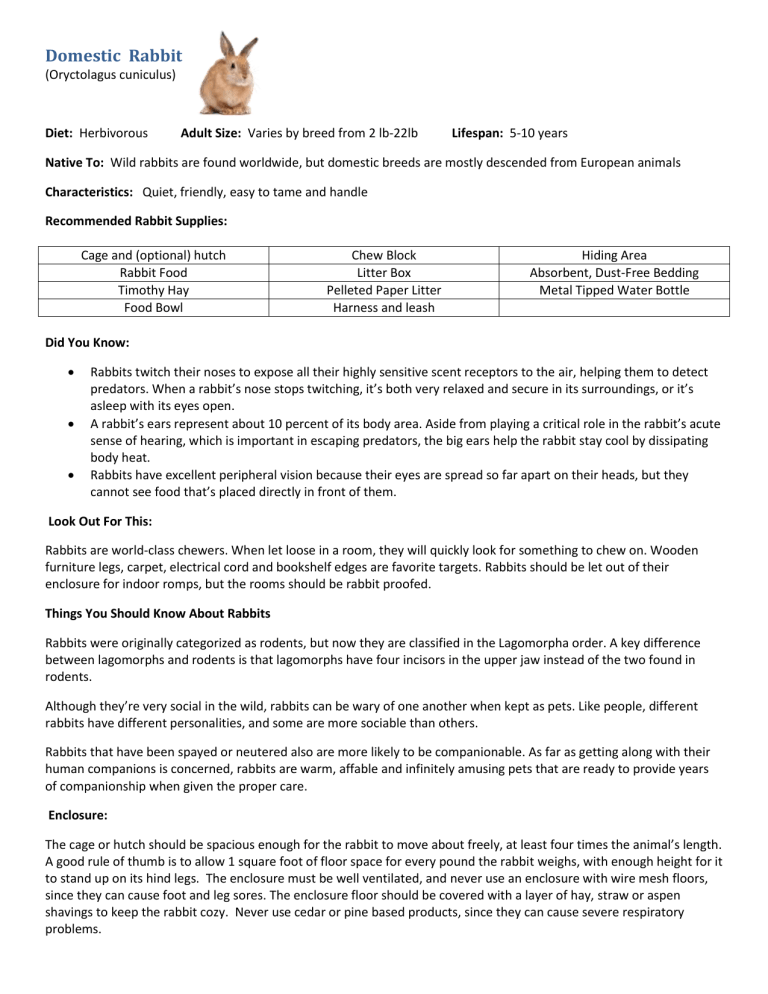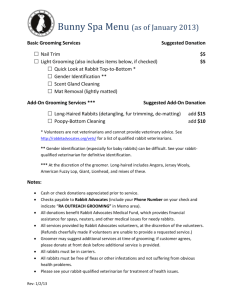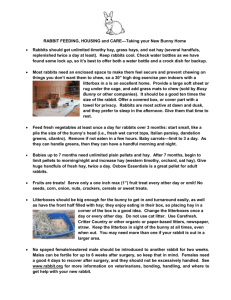File - Critters Exotic Pets

Domestic Rabbit
(Oryctolagus cuniculus)
Diet: Herbivorous Adult Size: Varies by breed from 2 lb-22lb Lifespan: 5-10 years
Native To: Wild rabbits are found worldwide, but domestic breeds are mostly descended from European animals
Characteristics: Quiet, friendly, easy to tame and handle
Recommended Rabbit Supplies:
Cage and (optional) hutch
Rabbit Food
Timothy Hay
Food Bowl
Did You Know:
Chew Block
Litter Box
Pelleted Paper Litter
Harness and leash
Hiding Area
Absorbent, Dust-Free Bedding
Metal Tipped Water Bottle
Rabbits twitch their noses to expose all their highly sensitive scent receptors to the air, helping them to detect predators. When a rabbit’s nose stops twitching, it’s both very relaxed and secure in its surroundings, or it’s asleep with its eyes open.
A rabbit’s ears represent about 10 percent of its body area. Aside from playing a critical role in the rabbit’s acute sense of hearing, which is important in escaping predators, the big ears help the rabbit stay cool by dissipating body heat.
Rabbits have excellent peripheral vision because their eyes are spread so far apart on their heads, but they cannot see food that’s placed directly in front of them.
Look Out For This:
Rabbits are world-class chewers. When let loose in a room, they will quickly look for something to chew on. Wooden furniture legs, carpet, electrical cord and bookshelf edges are favorite targets. Rabbits should be let out of their enclosure for indoor romps, but the rooms should be rabbit proofed.
Things You Should Know About Rabbits
Rabbits were originally categorized as rodents, but now they are classified in the Lagomorpha order. A key difference between lagomorphs and rodents is that lagomorphs have four incisors in the upper jaw instead of the two found in rodents.
Although they’re very social in the wild, rabbits can be wary of one another when kept as pets. Like people, different rabbits have different personalities, and some are more sociable than others.
Rabbits that have been spayed or neutered also are more likely to be companionable. As far as getting along with their human companions is concerned, rabbits are warm, affable and infinitely amusing pets that are ready to provide years of companionship when given the proper care.
Enclosure:
The cage or hutch should be spacious enough for the rabbit to move about freely, at least four times the animal’s length.
A good rule of thumb is to allow 1 square foot of floor space for every pound the rabbit weighs, with enough height for it to stand up on its hind legs. The enclosure must be well ventilated, and never use an enclosure with wire mesh floors, since they can cause foot and leg sores. The enclosure floor should be covered with a layer of hay, straw or aspen shavings to keep the rabbit cozy. Never use cedar or pine based products, since they can cause severe respiratory problems.
Litter Box:
Being very clean animals by nature, rabbits will often choose to designate one corner of their enclosure as the bathroom in order to keep the rest of their living quarters fresh. If it becomes apparent that more droppings are being found in one part of the cage than anywhere else, a litter box should be placed there. After lining it with newspaper, fill it with hay or pelleted newspaper cat litter. Clay cat litters should not be used, since they can cause digestive or respiratory problems in rabbits. Clean out the litter box daily. If the rabbit seems reluctant to use the litter box at first, place a few of its own droppings inside to help it understand the box’s purpose.
Temperature & Humidity:
Rabbits will do fine at normal room temperatures, provided things don’t get too hot. A rabbit is much better equipped to handle cooler temperatures than warmer ones. If the thermometer reaches 80 degrees Fahrenheit or higher, heatstroke becomes a real risk for rabbits.
Food & Diet:
Rabbits need a constant supply of a grass hay such as rye grass or timothy hay. Limited commercial rabbit pellets or dry food can also be given. Rabbits also enjoy a mix of fresh leafy greens such as spinach, collard greens, red or dark green lettuces, turnip greens and carrot tops. As an added step, rabbits should be provided with wooden chew toys and blocks.
Your rabbit should have yearly oral exams by a veterinarian. If there are problems, early treatment is the best.
Water:
Rabbits need a constant supply of clean, fresh chlorine-free water, most preferring a cage-mounted drinking bottle to a dish. Change the water daily, and check for leakage - the water should only come out when the animal sips at the tube.
Note: All water given to this pet must be 100% free of chlorine and heavy metals. We recommend that you use unflavored bottled drinking water or bottled natural spring water and never untreated tap water. Do not use distilled water, which can cause severe medical problems, since it lacks minerals that are essential to important body functions.
How to Handle A Rabbit:
A rabbit that is handled at a young age typically becomes very comfortable with the whole notion of being held by a human companion. When picking up a rabbit, approach the animal slowly and calmly, speaking in a gentle voice. Gently pull the rabbit toward you, placing one hand against his hindquarters, and softly holding the scruff of his neck with the other hand. Then place one hand under the rabbit’s chest and the other under his rump. It’s critically important to support the rabbit’s hindquarters to protect against spinal injuries.
Cleaning The Enclosure:
As is true for other small pets, a clean cage is critical to a rabbit’s good health. Many of the most common ailments afflicting pet rabbits can be traced to dirty enclosures. A pet rabbit’s cage should be inspected daily, and uneaten food and fecal material should be removed. Inspect the bedding at the start and end of every day, picking out droppings and removing uneaten food. Empty out, clean and refill the litter pan daily, disinfecting it weekly. Once a week, empty out all the bedding and thoroughly clean the hutch and accessories with hot, soapy water using a scrubbing brush. Rinse and dry everything thoroughly before putting in fresh bedding and replacing the accessories.
This material is a general guideline, and is not intended to serve as your sole sources of pet care information. Visit a veterinarian and consult a broad range of literature to ensure that your pet receives adequate care.



